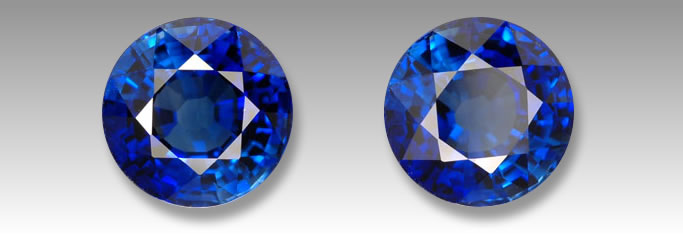GemSelect Newsletter - March 2010In our newsletter this month:
Sapphire Capital of the World Back to Top
Our home of Chanthaburi, Thailand is one of the main international centers for cutting colored gemstones. Traders bring rough stone here from mines all over the world, and we see nearly every kind of colored stone that reaches the market. Though we deal in more than 115 different varieties of colored gems, the specialty of Chanthaburi has always been ruby and sapphire. However, with the decline in the world ruby supply, and the introduction of new ruby treatments such as fracture-filling with lead glass, high quality sapphire has become the leading gemstone of the town. In fact, so much of the world's supply of fine sapphire passes through Chanthaburi that this modest town on the eastern seaboard of Thailand can fairly be called the sapphire capital of the world. The sapphires cut in Chanthaburi come from every important sapphire mining location. Years ago, many of the sapphires traded here came from the local mines in Chanthaburi and Trat, as well as from those just across the border in the Pailin province of Cambodia. In fact, the name pailin was adopted into the Thai language as the word for blue sapphire. As the local mines were exhausted, sapphires from Burma and Ceylon (Sri Lanka) became the mainstay of the local trade. Chanthaburi gem dealers had become experts at heat-treating sapphire, and they were able to improve the color and clarity of many types of sapphire. They had major successes with the the milky-colored geuda sapphire from Sri Lanka, and then with the inky blue corundum from Australia. About 10 years ago, the Thai gem burners figured out how to produce vivid yellow and orange sapphire by beryllium diffusion of pale, off-color sapphires from the Songea region of Tanzania. Ceylon sapphire continues to be a major factor on the market. Also, recent years have seen an increase in high quality African sapphire. The recent finds in Madagascar have seen the appearance of some top-grade blue, pink and color-change sapphires, including some hard to find larger sizes (over 2 carats). The most recent development is completely untreated sapphire from Tanzania in a wide range of pastel colors - blue, yellow, pink, orange, violet and green. Fine examples of the full range of sapphires produced in Chanthaburi can be seen in our inventory of nearly 3,000 sapphires. Though high quality rubies are now hard to find, the sapphire market is still going strong and prices, though rising, are still very attractive. Rare and Unusual Gems Back to Top
Each month we feature a rare and unusual gem from our inventory. In keeping with this month's article on sapphires from the Chanthaburi gem market, we feature a 2.2 carat royal blue sapphire, mined in Sri Lanka and cut in Chanthaburi: 
Royal Blue Sapphire from Gemselect
Royal blue - a deep blue with just a hint of purple - is the most valuable color in blue sapphire. It is the blue most often associated with the very fine rare sapphires from Kashmir. However, sapphires in this color can also be found from Sri Lanka and Madagascar. This 2.2-carat stone is graded VVS (almost loupe clean) and is a 7 mm calibrated round, perfect for a very impressive ring. Customer Questions Back to Top
Every month we answer questions of general interest from our customers. Please feel free to send your questions or suggestions to our support team at help@gemselect.com! Question
I have noticed with many pear-shaped gems, that the color is darker at the ends, particularly at the long narrow end. Can you explain why that is? Thank you for your answer. CR, UK.
Answer
You will observe this phenomenon in many pear-shaped gems, especially in lighter tones. It appears that the color is concentrated at the tip. The explanation has to do with the absorption of color and the length of the light path. A yellow gem appears yellow because it absorbs all frequencies of light except those in the yellow part of the spectrum. A longer path of light through the gem results in more light being absorbed, and more color reflected to the eye. The narrow tip of a pear-shaped gem lengthens the light path and can give the appearance of a concentration of color at the tip.
Question
Are there any gemstones that are used in their natural state (not cut and polished)? AS, Germany.
Answer
Gemstone material which has not been extensively cut or shaped and polished is usually referred to as "rough stone". Rough stone is of interest to mineral collectors, but it is not generally set in jewelry in its raw state (though some jewelry designers have tried). The one notable exception to this rule is pearl. Most natural and cultured pearls have not been modified by man in any way, and the distinctive luster of pearls is due entirely to the reflection, refraction and diffraction of light from the translucent layers. No polishing is required.
Keep up with our new arrivals before they hit the newsletter by joining our thousands of fans and followers on our social networking pages. We love interacting with our customers - you can visit us on Tumblr, LinkedIn, Twitter, Facebook or Pinterest! To ensure you can receive our emails, please be sure to add help@gemselect.com to your list of safe contacts, or you add us into your email address book! Please feel free to contact us with any questions, comments and queries! We respond to each and every email we receive. Happy Gem Hunting! This Page in Other Languages
|
| STAY IN TOUCH | NEWSLETTER |
| *You're signing up to receive GemSelect promotional email. |
Copyright © 2005-2024 GemSelect.com all rights reserved.
Reproduction (text or graphics) without the express written consent of GemSelect.com (SETT Company Ltd.) is strictly prohibited.
1178